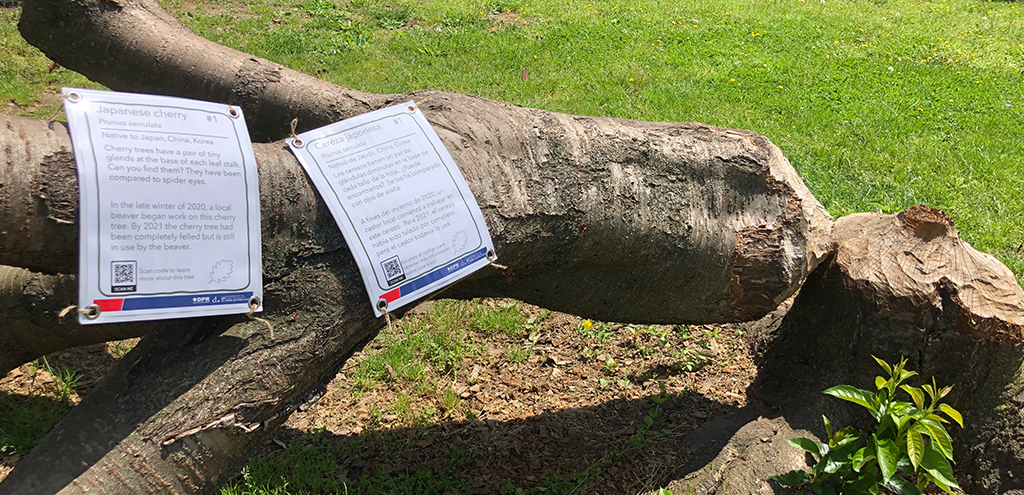THE LEAFLET

DDOT’s Pop Up Arboreta
There are three (and counting) arboreta run by the District Department of Transportation (DDOT). Marvin Gaye Park and Oxon Run were the first two and were chosen because of their location, size, and breadth of community connections. The third, located in Langon Park is the one we’ll focus on. Read more about its Pop-Up Arboretum or experience it in person in September at the Urban Tree Summit. Our last field session will be an interactive, in person tree walk with our Executive Director Mark and the Associate Director of DDOT’s Urban Forestry Division (UFD) Earl. This is your chance to not only learn more about local trees, but also to learn more from the pros and ask your questions. Register now for our Langdon Park Tree Walk with UFD on September 23.
March 2020 brought quite a few cancellations to the DMV, including the city’s second annual Arbor Day Fest. Their celebration of all things city trees gets the community out, gives them a chance to connect with the public, showcases urban trees, and introduces people to the nature surrounding them. We chatted with UFD’s Forest Health and Community Outreach Specialist Kasey Yturralde, PhD on the creative way they pivoted and what’s next.
As we mentioned, the public health emergency announced in mid-March of last year canceled any and all public events, but as Kasey elaborated DDOT still very much “wanted to continue to connect with the public” since it’s important to increase the exposure of knowledge of the Urban Forestry Division, city arborists, and trees. While Kasey’s (and to some extent city arborists) goal is to connect people with nature in general, during the pandemic it became important to people to connect to nature locally.
Urban forestry is a collaborative field, so Kasey turned to other cities to see how they were engaging residents when everyone couldn’t gather, and we were mostly indoors. Enter: a pop-up arboretum. No matter how small the park space, all you needed were trees. Signs could then be placed on the trees with fun facts, descriptive information, or stories to encourage residents to wind their way through the park and explore the other signs and trees. “It sounded like a fun idea,” she explained, “Folks love arboreta and museums, interpretive signage is fun to have up and more importantly, it can be experimental, temporary, and inexpensive.” It’s hard to remember, but there was so much uncertainty during those early days of the stay-at-home orders. Kasey went on to say that it was important to engage the community, but not zap precious UFD resources.
Another important part? Community engagement. Langdon Park came up quite a bit because it’s one of the District’s larger, dynamic parks with lots of activities for a range of ages. Community based events that aren’t tailored to the community aren’t quite achieving their objective, so Kasey and team UFD connected with neighborhood contacts, presented at local SMD/ANC meetings to get feedback, and ended with a walk through with the robust Friends of Langdon Park organizations. All this effort ensured that the Arboretum would be used and loved by its neighbors and that the community was involved from the start.
Once the idea of an arboretum in a park with signage was born, next came the fun part: creating the signs! Kasey shared that the team of arborists that chose the trees wanted to find a unique mix of trees to highlight in the park. “It was important to us that the tree identification be fun, but also be useful for folks to recognize that they’ll encounter a lot of these trees on their street. So, we went with species like dogwoods, redbud, red oak, red maples, trees like that.” But they didn’t want to limit themselves to common trees found in parks and streets. “It was also a great opportunity to bring attention to some unusual trees that will only be found in Langdon Park.” Kasey shared. “There are some unique trees in the Park. For example, there’s a southern red oak with a hollow that is being actively cultivated. Or the tree in Oxon Run Park that a beaver felled [see the article photo]. We also wanted to mention interesting features of individual trees or things that would draw attention. There’s a great tulip poplar with limbs that come down to the sidewalk so you can really see the flowers.”
While it was easy for UFD arborists to identify what trees to create signage for, putting together the content for each sign was a bit trickier. Enter yet another wonderful city partner, the Smithsonian Gardens! With links to their Garden Explorer maps, Kasey and her team were able to show even more photos of tree characteristics and, more importantly, show folks where to find trees on the National Mall. Being able to take advantage of such a helpful resource was a key part of putting the Arboretum together, Kasey elaborated.
Ultimately the Arboreta were an experiment gone right. A chance for folks to gather safely outside, learn something new in their community, and provide an opportunity for residents to learn more about their neighbors – the trees – and the people that care for them – UFD. And what’s next for UFD? Kasey shared that they’ll continue focusing on inventorying trees as well as keeping an eye out on cicada damage. Another timely topic for UFD’s focus? Continuing to assess their mix of city trees with regard to climate change and adjusting how they select trees based on how they will fare in future climates. While a lot of urban foresters’ work has changed because they’re now in the field full time, Kasey ended on a poetic note, “regardless of how we accomplish it, our goal for outreach is always to get to know folks and introduce them to urban trees. If you see an arborist at work around the city, stop by and say hi.”